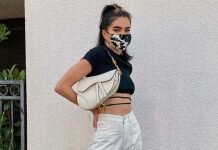Justine Porterie doesn’t use the word “consumer.” Call them “people,” call them “humans,” it’s up to you — just divest individuals from their purchasing power, because we’re all so much more than the physical goods we buy.
“The premise of interrogating and reshaping fashion consumption starts in our heads,” Porterie tells me from London, where she’s based. “It’s stepping away from a consumer mindset to being a citizen.”
This is, of course, a seemingly counterintuitive perspective to have when one works at a shopping app, but it’s just not any shopping app. Porterie is the global head of sustainability at Depop, the peer-to-peer sales platform for secondhand clothing that has effectively — to quote The Cut — hooked Generation Z on thrifting. And the numbers don’t lie: As of figures released last August, Depop had more than 26 million registered users (in nearly 150 countries), 90% of which were Gen Z. With a feed that’s structurally similar to Instagram, Depop has given concepts like circularity and upcycling a punchy social-media feel.
Yet Depop isn’t exactly your picture of overnight success. The marketplace was founded in Italy in 2011 before relocating to London, where it’s now headquartered, a year later. It repositioned itself a number of times, most recently to hone in on its sustainability commitments, just before Porterie came on board.
Having cut her teeth on the sustainability side of the corporate world (at the likes of Ernst & Young, Accenture and Unilever) for close to eight years, Porterie was recruited to join an incubator program and created her own company soon after. Called Outstand, the business specialized in curating vintage fashion as an answer to curbing apparel’s waste crisis. It was also what got her in the door at Depop.
“It was very early days when I met [Maria Raga], the CEO of Depop, for insights on Outstand, because Depop is Depop, and it was already a 19 million user platform at the time,” she remembers. “So I thought, ‘Amazing. She can provide me with invaluable information.’ And, the rest is history, basically.” Which is to say that Porterie began consulting with Depop on its sustainability efforts, and later joined the team in an official capacity, in February 2020.
Related Articles:
How Clare Bergkamp Became One of the Most Quietly Influential Figures in Sustainability
The Pandemic Transformed Fashion’s Sustainability Narrative in 2020
Across the Country, Vintage Shops Are in a Fight to Save Thrifting
Today, Porterie’s job is to rethink resale’s environmental footprint. The ultimate goal is to create a new fashion system, but in the intermediary, the plan includes offsetting shipping emissions (which Depop enacted last January) and achieving climate neutrality by the end of 2021. Depop also has plans to achieve 100% renewable energy in all its offices and workspaces, as well as to partner with select energy providers to offer preferential offers to switch to renewable energy. (The company’s full sustainability plan through 2022 is made available for view here.)
We hopped on Zoom to chat with Porterie about her career experience, her behind-the-screen perspective and her most applicable suggestions for those people — not consumers — looking to try their hand at resale. Read on for the highlights.
What first interested you about this intersection of fashion and sustainability?
I started with sustainability, period. The reason being that I come from a humble background, and I got lucky enough to access one of the best business schools in France. So when I got to this state of thinking, “Okay, what do I want to do?” — I immediately wanted to give back. Let’s make it about something more than me.
Fashion came further down the line, after having worked with some of the biggest companies on implementing and embedding sustainability in their ways of working. I just felt I needed to get closer to the ground, and joined an incubator program to create my own company.
I started to research problems, and I looked into so many things, from furniture to food, and then I stumbled upon fashion, realizing that something like eating organic is becoming more and more understood, but fashion is not there yet. I never looked back, and decided to dedicate myself to fashion. I know a lot of people working in fashion are super-passionate; they’ve dreamt about working in the fashion industry their whole lives. Not in my case. I love it now, but it was an impact-driven decision.
What can you tell me about starting your own company?
It was a roller coaster of an experience. The program was slightly different than the usual incubator as in, they would recruit people rather than projects and ideas.
As I said, I decided to focus on fashion because it felt like there was a lot of untapped potential and under-used assets there. l started with styling, thinking, “How can I get people to just use what they have?” I looked into repair and upcycling, and then finally landed on resale. That’s how Outstand came to life. It was meant as a marketplace, targeting millennials, the idea being, “How can I get shopping secondhand to be as easy as buying something new?”
How did the Depop opportunity come about?
It was totally organic, like the planets were aligned. I was building this resale marketplace with slightly different origins than Depop, and she let me know that the brand had just been repositioned, and sustainability was a core part of it. She was starting to think, “How can we become more strategic about it?” So I offered my help.
It wasn’t perfect. I had Outstand on the side, and then I was helping one of the fastest-growing companies in resale. I kept Outstand on the side while setting up the first roadmap for Depop. And at the end of my contract, they offered me to stay and lead the sustainability effort. It ended up being a no-brainer because having 19 million users when we have 10 years to tackle climate change… I jumped.
What does your role look like in a day-to-day sense?
I’m doing so many things. We’ve just released our two-year sustainability plan. That was a big piece of work I’m super proud of, both personally and for the entire company. One thing in there that I’m particularly proud of, and that we’re actively working on, is our climate-neutrality goal for the end of the year. We started already by addressing the biggest driver to that, which is our shipping footprint.
From now on, systematically in our brand partnerships, we make sure that any garment that’s produced as part of our collaborations is either circularly- or responsibly-made. Setting those standards takes time, and you probably know there’s no agreed-upon standards across the industry on what “responsible” or “circular” means.
Right. Which may explain why, despite its many environmental and ethical benefits, there’s still quite a stigma that surrounds vintage and secondhand fashion. What do you believe the industry needs to do to dispel those stigmas?
Depop is a striking example of how you can naturally fight that stigma. It’s interesting because when I talk to people who are outside the Depop community, I forget there’s a stigma because it just no longer exists here. And the beauty of Depop is that the community made secondhand cool. You don’t come on Depop because it’s secondhand — you come on Depop because there are cool items that are well-styled and well-merchandised; you like the experience, and then you stay because of the community. So I think rather than making it about secondhand, brands and retailers can just make it about the item itself. At the end of the day, we’re talking about clothes.
It’s about tapping into behaviors, rather than trying to necessarily market the sustainability advantage. And that’s where the Depop model is so powerful. You come in and may not be aware you’re doing something great for the planet, but then our role is to validate that so you come back. And then you re-plant that seed, which makes you, hopefully, interrogate other parts of your lifestyle. I like to think that we act as a gateway to more sustainable behaviors, but in a very natural and non-pushy way. You come as you want, as you are. And then once you’re in, we help you realize that you’re actually doing one little good thing for the planet.
A recent study estimated that 82% of the U.S. hasn’t yet resold clothing, though most people are open to doing so. How can those who haven’t yet participated in the secondhand market themselves get involved?
Whenever I get asked that question, the first thing I say is to interrogate your needs. But even before that, step back from that position of consumer. We have that power, and sometimes the best thing to do is to think twice before reverting to buying something new and to understand what your needs are. If it’s a one-off need, maybe you don’t need to own the product, and maybe you can borrow it or rent it if it’s a wedding, or whatever. If you know you’re going to wear it a number of times, then you turn to resale.
Sometimes you have very niche needs, so you’ll have to buy new. But if you really, really need something and can’t find it secondhand for whatever reason, that’s when you look into something that’s responsibly-made. You may not find that piece, according to your sustainability standards, and that’s when you literally pick up your laptop and you write an email to your favorite brand and ask them, “Can I find information about your sustainability strategy?” You can step out of the shoes of a consumer who just takes, and instead actually contribute to shaping the future by simply asking questions.
And I see it. I receive questions from our community all the time. We’re a community-based business, so we have a community that’s very vocal, which is great because they hold us accountable. The point is, everyone can do that. And most of the time, if you take the time to put out your request in an intelligible way, someone will respond to you, and that gets escalated. It’s as simple, sometimes, as writing an email.
When you think about the future of sustainability and circular fashion, where do you imagine it going?
The waste problem is so massive that solutions will need to come from a number of ends. Resale is a powerful tool. There are other things that need to happen at the same time, but namely, we need less, but better. We obviously need to use and explore what’s already there as much as possible, and resale is part of the solution. And I’m excited to see that resale has picked up even faster during the last year because it shows that behaviors are changing. Even if you started shopping or selling secondhand during the pandemic because you were bored, you’ll very likely keep on doing it.
But then at the end of the value chain, when resale isn’t an option because the garment is no longer in a good shape, what do you do with those fibers and those clothes? And at the moment, that’s still a big question mark. Less than one percent of fibers are recycled. We need all hands on deck throughout the chain, but the recycling bit is definitely going to be critical because we just keep on producing loads and loads. People wear less and less, and we don’t know what to do at the end of the garments’ life when 70% of what we produce ends up in a landfill, which is mind-blowing and not a good use of resources for a planet that has an expiration date, literally.
What advice would you give someone who wants to build their own career in fashion sustainability?
The reality is, the market is becoming more and more competitive, which means that companies need technical people. For those who are very interested in sustainability positions, they need to pick a topic they’re passionate about. Is it climate? Is it regenerative agriculture? Is it end-of-life and recycling techniques? By staying in your lane and being an expert in product or marketing or tech or engineering, and then joining a business like Depop, you’re part of the sustainable fashion movement. We need all hands on deck, and we need experts in those topics.
Never miss the latest fashion industry news. Sign up for the Fashionista daily newsletter.
!function(f,b,e,v,n,t,s){if(f.fbq)return;n=f.fbq=function()
{n.callMethod? n.callMethod.apply(n,arguments):n.queue.push(arguments)}
;if(!f._fbq)f._fbq=n;
n.push=n;n.loaded=!0;n.version=’2.0′;n.queue=[];t=b.createElement(e);t.async=!0;
t.src=v;s=b.getElementsByTagName(e)[0];s.parentNode.insertBefore(t,s)}(window,
document,’script’,’https://connect.facebook.net/en_US/fbevents.js’);
(function(){
fbq(‘init’, ‘196671577729406’);
fbq(‘track’, ‘PageView’);
var contentId = ‘ci027d3cadd00027c4’;
if (contentId !== ”) {
fbq(‘track’, ‘ViewContent’, {content_ids: [contentId], content_type: ‘product’});
}
})();
Source link


































